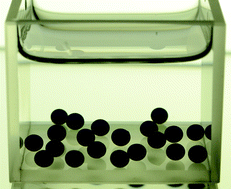A conductive hydrogel based on alginate and carbon nanotubes for probing microbial electroactivity†
Abstract
Some bacteria can act as catalysts to oxidize (or reduce) organic or inorganic matter with the potential of generating electrical current. Despite their high value for sustainable energy, organic compound production and bioremediation, a tool to probe the natural biodiversity and to select most efficient microbes is still lacking. Compartmentalized cell culture is an ideal strategy for achieving such a goal but the appropriate compartment allowing cell growth and electron exchange must be tailored. Here, we develop a conductive composite hydrogel made of a double network of alginate and carbon nanotubes. Homogeneous mixing of carbon nanotubes within the polyelectrolyte is obtained by a surfactant assisted dispersion followed by a desorption step for triggering electrical conductivity. Dripping the mixture in a gelling bath through simple extrusion or a double one allows the formation of either plain hydrogel beads or liquid core hydrogel capsules. The process is shown to be compatible with the bacterial culture (Geobacter sulfurreducens). Bacteria can indeed colonize the outer wall of plain beads or the inner wall of the conductive capsules' shell that function as an anode from which electrons produced by the cells are collected.



 Please wait while we load your content...
Please wait while we load your content...